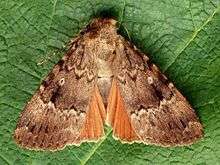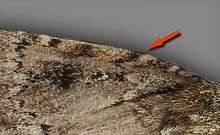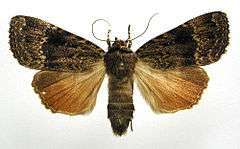Copper underwing
The copper underwing, humped green fruitworm or pyramidal green fruitworm (Amphipyra pyramidea) is a moth of the family Noctuidae. The species was first described by Carl Linnaeus in his 1758 10th edition of Systema Naturae.
| Amphipyra pyramidea | |
|---|---|
 | |
| Copper underwing moth | |
| Scientific classification | |
| Kingdom: | |
| Phylum: | |
| Class: | |
| Order: | |
| Family: | |
| Genus: | |
| Species: | A. pyramidea |
| Binomial name | |
| Amphipyra pyramidea | |
Distribution
This species can be found throughout the US and southern Canada[1] as well as across the Palaearctic region including Europe, North Africa, the Near East, Iran, southern Siberia, northern India, Korea and Japan.[2][3] It is rather common over the southern half of Britain.[4]
Description
This species has a wingspan of 47–54 mm,[4] the female usually slightly larger than the male. The forewings are brown marked with paler fascia and a pale, dark-centred stigma. The hindwings are a rich bright copper colour (hence the common name of "copper underwing").
It is very similar to Svensson's copper underwing (Amphipyra berbera) but identification is usually fairly straightforward by looking at some markings on the forewings,[5] the detail of the labial palps[4] and at the underside of the hindwings. This species has a pale area in the centre of the hindwings, contrasting with much darker marginal areas, while in A. berbera the whole underwing is more or less uniform in colour. The larva is green with white markings and a pointed hump at the rear end.
Differentiation of A. pyramidea from A. berbera
 A. pyramidea - red arrow points out a difference
A. pyramidea - red arrow points out a difference A. berbera - red arrows point out a difference
A. berbera - red arrows point out a difference Caterpillars of A. pyramidea (top) and A. berbera
Caterpillars of A. pyramidea (top) and A. berbera
Biology
It is a univoltine species. Hatching season is as early as June in some climates but they usually hatch July to October. Eggs are laid in deciduous trees. Larva can be found as early as April in some climates but usually emerge in May–June. A pyramidea flies at night from August to October and is attracted to light and strongly to sugar.[4] It feeds on a variety of trees and shrubs, including ash tree (Fraxinus), privet (Ligustrum), honeysuckle (Lonicera), apple (Malus), oak (Quercus), Rhododendron, rose, wild service tree (Sorbus) and lilac (Syringa).[6][4][2][7] The species overwinters as an egg.
- ^ The flight season refers to the British Isles. This may vary in other parts of the range.
Gallery
 Larva
Larva- Moth
 Mounted specimen
Mounted specimen Illustration
Illustration
References
- McLeod, Robin (20 October 2019). "Species Amphipyra pyramidoides - Copper Underwing - Hodges#9638". BugGuide. Retrieved 23 October 2019.
- Savela, Markku (28 July 2019). "Amphipyra pyramidea (Linnaeus, 1758)". Lepidoptera and Some Other Life Forms. Retrieved 23 October 2019.
- Fauna Europaea
- Kimber, Ian. "73.062 BF2297 Copper Underwing Amphipyra pyramidea (Linnaeus, 1758)". UKMoths. Retrieved 23 October 2019.
- Entomart
- Robinson, Gaden S.; Ackery, Phillip R.; Kitching, Ian J.; Beccaloni, George W.; Hernández, Luis M. (2010). "Search the database - introduction and help". HOSTS - A Database of the World's Lepidopteran Hostplants. Natural History Museum, London.
- Mazzei, Paolo; Morel, Daniel & Panfili, Raniero. Moths and Butterflies of Europe and North Africa
- Chinery, Michael (1991). Collins Guide to the Insects of Britain and Western Europe.
- Skinner, Bernard (1984). The Colour Identification Guide to Moths of the British Isles.
External links
| Wikimedia Commons has media related to Amphipyra pyramidea. |
- Butterflies & Moths of Switzerland
- Lepiforum e.V. Includes photo of genitalia.
- Portal für Schmetterlinge und Raupen